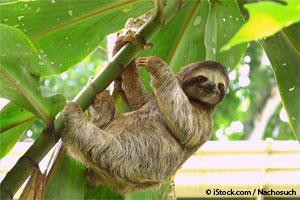


- Feed only at night
- Eat in every position. Pull a leafy branch to mouth, break it off and then hold stem between palm and claw, turning and pushing the stem forward to eat the leaves
- Large thick tongue, densely covered with sharp, minute, backward-directed spines
- Slow metabolic rate means they can survive on a small amount of nourishment. They are quite light weight for a mammal their size, which is helpful when harvesting leaves from long, thin branches.
- Seldom drink. Moisture is obtained from plant matter and dew on leaves
- Metabolic rate is only about 40 to 60% of that of other mammals this size (Gilmore 2000)
- Food has low energy content — may contain poisonous compounds that require low rate of absorption for detoxification
- Digestion occurs in a large 4-chambered stomach (like ruminants) but unlike ruminants who possess long intestines, the sloth intestine is short (even shorter than in carnivores)
- Bacteria hydrolyze the plant cellulose
- Digestion slows in lower temperatures — increased mortality has been observed in cold, rainy months (Sunquist & Montgomery)
- Passage of food through gut takes 6-21 days. (Usually takes hours for other herbivores); process is similar in tortoise (Parra 1978)
- Young leaves digested at highest rates. Only mature leaves of certain species can be digested quickly enough to avoid starvation
- Due to its slow metabolism and high-cellulose diet, defecation and urination occur only once a week. Descends to ground to deposit mass of fecal pellets and urinate (occur simultaneously)
- Weight loss due to elimination has exceeded 30% of body weight but this is exceptional

- Feed only at night
- Eat in every position. Pull a leafy branch to mouth, break it off and then hold stem between palm and claw, turning and pushing the stem forward to eat the leaves
- Large thick tongue, densely covered with sharp, minute, backward-directed spines
- Slow metabolic rate means they can survive on a small amount of nourishment. They are quite light weight for a mammal their size, which is helpful when harvesting leaves from long, thin branches.
- Seldom drink. Moisture is obtained from plant matter and dew on leaves
- Metabolic rate is only about 40 to 60% of that of other mammals this size (Gilmore 2000)
- Food has low energy content — may contain poisonous compounds that require low rate of absorption for detoxification
- Digestion occurs in a large 4-chambered stomach (like ruminants) but unlike ruminants who possess long intestines, the sloth intestine is short (even shorter than in carnivores)
- Bacteria hydrolyze the plant cellulose
- Digestion slows in lower temperatures — increased mortality has been observed in cold, rainy months (Sunquist & Montgomery)
- Passage of food through gut takes 6-21 days. (Usually takes hours for other herbivores); process is similar in tortoise (Parra 1978)
- Young leaves digested at highest rates. Only mature leaves of certain species can be digested quickly enough to avoid starvation
- Due to its slow metabolism and high-cellulose diet, defecation and urination occur only once a week. Descends to ground to deposit mass of fecal pellets and urinate (occur simultaneously)
- Weight loss due to elimination has exceeded 30% of body weight but this is exceptional
What Does Sloth Eat
Sloths are known for their slow nature, but that's due to the relatively low quality diet they consume. Juslit solar light. Most sloths eat a regimen of toxic leaves that provide little energy and can take up to a month to properly digest – in fact, if they digested any faster, the toxicity would poison them. Slots on youtube 2021 tigers. Because sloths only eat leaves from a few trees, their diet is very low in nutrition. Therefore, they can't expend a lot of energy to regulate their body temperature.

